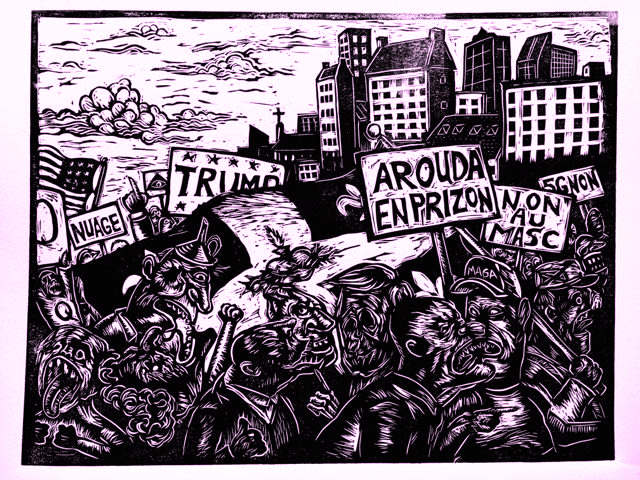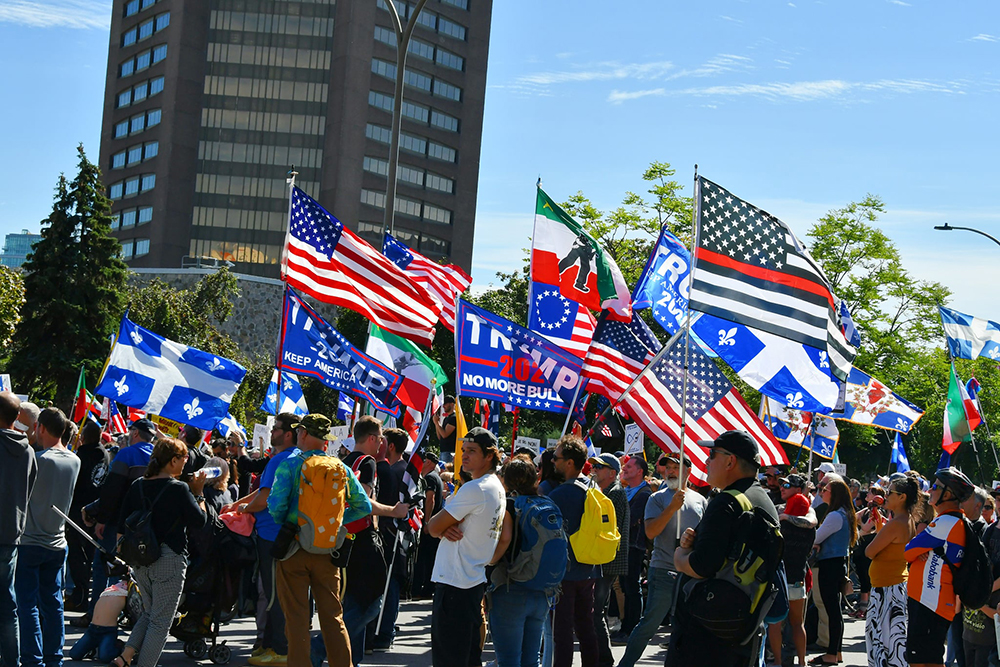[This article was written for L’Idiot utile, vol. 2, #1, published in October 2020.]
Since 2017, Montréal Antifasciste has struggled against the resurgence of the far right in Quebec, particularly the national-populist variety. This reactionary movement, egged on by years of racist propaganda and machinations by a section of the political establishment along with the Québecor media empire (e.g., the tempest in a teapot about reasonable accommodations, the Charter of Quebec Values project, etc.), grew in significance in 2016 and 2017 (in step with the rise of Donald Trump in the United States) and crystallized around a set of anti-Muslim and anti-immigrant themes. The Islamophobic and xenophobic organizations that gained a foothold in Quebec, such as La Meute and Storm Alliance, ended up imploding just as they were cresting this wave, in no small part thanks to the sustained efforts of antifascists and antiracists.
Unfortunately, the national-populist far right had already managed to pollute the popular debate, and as a result of media complacency and the normalization of a particular pernicious discourse, which was manipulated for electoral purposes, the rise to power of the Coalition Avenir Québec (CAQ) and the speedy promulgation of Bill 21 (on state secularism) constituted a sort of final chapter in this reactionary period. Having succeeded in bringing a sympathetic political formation to power, the Islamophobes, trembling in fear of Sharia law and the Great Replacement, needed to find a new sandbox to play in. Happily for them and unfortunately for the rest of us, the COVID-19 pandemic provided the perfect terrain onto which they could project their irrational fears, pushing simplistic answers to complex questions while broadening and consolidating their base.
Since the beginning of the pandemic, and especially since the lockdown in mid-March, we have seen certain central players from the Islamophobic and anti-immigration groups of recent years reappearing as leading figures against public health and safety measures.[1] It doesn’t take any great research skills to see, as has been noted by many, that several of the more narcissistic personalities from these groups are now leading the conspiracy theory movement behind these mobilizations. We are also witnessing a clear convergence: a section of the Islamophobic and xenophobic national-populist movement that primarily developed on social media in recent years is associating with some of the more ideological elements of the far right (Catholic traditionalists, Nazis, etc.), with a section of the evangelical religious right, and with elements in the orbit of the New Age and alternative health movements. They have come together to constitute the current anti-health movement, a movement increasingly based in conspiracy theories that are completely detached from reality, notably the mind-boggling QAnon conspiracy theory.
The Far Right’s Fondness for Conspiracy Theories
We need to specify that conspiracy theories are not the sole province of the right or far right; a fair number of so-called progressives have also been seduced by the appeal of conspiracy theories. Nonetheless, it is clear that the current movement is part of a long tradition of overlap between the far right and conspiracy theories.
Since the early twentieth century, the far right has built on a variety of conspiracy theories centred on hidden forces and secret cabals said to manipulate history, states, finance, and the media, exerting behind-the-scenes control over the geopolitical chessboard and migratory movements, all with the ultimate goal of weakening nations and setting up an all-powerful world government. The most famous and undoubtedly the most influential example are those theories arising from the Protocols of the Elders of Zion, an antisemitic hoax published in 1903 by Russian ultranationalists loyal to the czar that was meant to feed the myth that an internal Jewish enemy threatened the stability of the empire. The Protocols, proven to be fraudulent by the 1920s, were an important inspiration for Hitler and the Nazis, as well as spawning a plethora of antisemitic currents across the planet throughout the twentieth century and a series of parallel theories advanced by the far right, including the “Kalergi Plan,” the “Great Replacement,” and, more recently, the pervasive myth of the hidden hand of the Hungarian Jewish billionaire George Soros, and finally culminating in the QAnon conspiracy theory phenomenon.
It’s important to appreciate the latter phenomenon in order to understand the current anti-health movement in Quebec (and the United States), for QAnon and its numerous codes (like the acronym WWG1WGA, meaning “Where We Go One We Go All,” and its image of Trump as a messianic figure) now cut across the entire movement, starting with its principal local booster, Alexis Cossette-Trudel and his video channel Radio-Québec.
QAnon adherents believe that an anonymous agent in the US intelligence community (the famous“Q”) has, since 2017, released a series of coded messages on the 4chan imageboard and subsequently on 8chan and 8kun forums about a “Deep State” controlled by a secret cabal of satanic, criminal, pedophile cannibals. This cabal, tied to the Democratic Party and the Hollywood elite, is constantly “about to be” unmasked as part of a “Great Awakening”, primarily as a result of the providential action of President Donald Trump, who is in fact some kind of secret agent whose true objective is to defeat the “Deep State”.
The QAnon phenomenon is a sort of updated version of the Protocols of the Elders of Zion, sanitized of its crudest anti-Semitism but integrating many of the main themes that have proven successful for classic antisemitic conspiracy theories, e.g., the existence of a secret world government (the Deep State, the globalist elite, international finance, etc.) and the diabolical nature of this alleged cabal (the stuff about “pedosatanist” cannibals directly echoes the Nazi myth of baby-eating Jews[2] as well as the “blood libel” defamation propagated in Europe since the Middle Ages).
Initially a marginal phenomenon confined to imageboards and other specialized websites, QAnon experienced an explosive growth in popularity when governments moved to impose various public health and safety measures, in part benefitting from the fact that many people suddenly had time on their hands to explore certain unsavoury corners of the internet. Given the current state of affairs, it’s somewhat beside the point whether QAnon is a prank that got out of hand, a con carefully orchestrated by unscrupulous scam-artists, or a psychological operation coordinated by some intelligence service: QAnon has now become an international phenomenon with millions of followers. Cossette-Trudel, a committed Q follower well before the pandemic, found himself in an excellent position to capitalize on this burgeoning craze by infusing the anti-health movement with elements of the QAnon conspiracy theory. And he has done this so effectively that they are now essentially one and the same.
The Anti-health movement: A Fertile Terrain and Recruiting Ground for the Far Right
The far right and the conspiracy theorists have value systems that share a lot in common and overlap especially in one aspect: populism. Populism rests largely on the myth of “the people” opposed to a secret elite with a hidden agenda. It would seem that the more adept among the populist leaders view the anti-health movement as a manifestation of this fabled “people” they have been calling upon to “awaken” for some years now. This makes the movement an ideal terrain for recruitment and for popularizing far-right ideas, something a former member of Storm Alliance recently confirmed in a conversation with the collectif Emma Goldman.
Most of the leading figures in the anti-health movement were also active in the national-populist milieu in recent years. Stéphane Blais, the person at the forefront of the pompously named Fondation pour la défense des droits et libertés du Peuple, along with Daniel Pilon and Jean-François Dubois, are key members of the Citoyens au Pouvoir fringe party, which was at a certain point very close to La Meute. Mario Roy, a key member of Storm Alliance and one of the ever-present loudmouths of the anti-health movement is also a sort of eminence grise of the same outfit, and Alexis Cossette-Trudel had previously run as one of its candidates. A number of observers have suggested that the current movement might well be a sort of grooming operation to lure the “enlightened” into Citoyens au Pouvoir. The recent rapprochement between Maxime Bernier (of the People’s Party of Canada) and Cossette-Trudel and the anti-health movement suggests a similar process is underway in that quarter. One might be tempted to think of the whole thing as a conspiracy…
The former no. 2 of La Meute, Steeve “l’Artiss” Charland, has also become one of the more influential members of the movement, specifically calling on his followers to “cut the cable,” which is to say, to cut themselves off from official sources of information and seek out “reinformation” sources controlled by conspiracy theorists and pandemic deniers. Besides Radio-Québec, there is the vlogger André “Stu Pitt” Pitre, whose StuDio has been very influential in the Islamophobic and anti-immigration movement. Another important propaganda node is the Théovox channel directed by the evangelical Christian Jean-François Denis. More marginal figures, including the YouTuber and professional weirdo Pierre Dion and the antisemitic vlogger Maxime Morin of the DMS “reinformation” project (who notably hyped the documentary Plandemic in Quebec) have also nudged their respective “fanbases” in the direction of the conspiracy theory movement. However, of this entire menagerie, Alexis Cossette-Trudel is doubtless the most influential.With 75,000 Facebook followers and a YouTube channel with approximately 119,000 subscribers, he certainly bears the greatest responsibility for the place that QAnon takes up in Quebec’s anti-health movement, and has helped to pull the movement into a symbolic pro-Trump camp as the 2020 American presidential election approaches. [Note: Radio-Québec’s Facebook page was shut down on October 7, 2020, as well as its YouTube channel, on October, 15th.]
An Incoherent Movement Awash in Contradictions
With the endlessly repeated mantra that we should “do our research,” it’s clear that the anti-health conspiracy theorists think history and science are on their side. As they see it, they are reasonable people operating on the basis of “common sense”, and anyone who isn’t on their side is clearly a brainwashed “sheep”. Ironically, as is the case for conspiracy theories in general and far-right theories in particular, the movement`s various claims often amount to little more than cultish irrationalism (note again QAnon’s slogan, “Where We Go One We Go All”) which is extremely impervious to fact-based arguments.
It is not for nothing that the leading figures in this movement insist on demonizing the mainstream media and encourage their followers to “inform” themselves on YouTube and a multitude of “alternative” news sources, each one weirder and wonkier than the last. The fake news and propaganda pushed by these dubious and fraudulent sources bounce around an echo chamber, spreading ad infinitum within the conspiracy theorists’ social media bubble. In 2018, an in-depth exposé on Radio-Canada showed how YouTube’s recommendation algorithms create a slippery slope, pushing people from conspiracy theory videos to outright far-right channels like Nomos.tv and DMS. As shown in the recent documentary The Social Dilemma, this is no accidental wrinkle but is an integral aspect of these platforms, which do everything they can to capture and retain users’ attention, even if this means leading them further afield to content making evermore unrealistic and ominous claims.
The radical left has long been highly critical of the mass media (for many reasons, including the role it plays in legitimizing the capitalist system and the liberal oligarchy), while also being at the forefront of the movement to democratize the media. Ironically, it now finds itself in the ambiguous and paradoxical position of defending the credibility of these same media sources given that the information they produce is more credible and rigorous that the crass disinformation that characterizes the “alternative” media landscape being built upon by conspiracy theorists and the far right.
In addition, conspiracy theorists and the far right work together to promote an anti-intellectual ethos hostile to scientific argument.[3] This clears the way for a certain convergence with the alternative health movement[4] (even though we tend to associate it more with a sort of touchy-feely left-liberalism), an important section of which has long denied the benefits of vaccination and fuelled extreme skepticism of anything related to institutional medical science or the pharmaceutical industry.[5] In the context of the COVID-19 pandemic, this mistrust and hostility is applied to international institutions like the World Health Organisation (WHO), seen as a tool of the “globalist” conspiracy, and to both provincial and federal health authorities, who are depicted a stooges of, if not out and out accomplices in, this conspiracy. Given all of this, it comes as no great shock to also find a fair number of climate change denialists and flat earthers in the anti-health movement.
In Quebec, this hostility has been directed at the political establishment, in particular the present government, with regulations on distancing, the lockdown, and the preventive health and safety measures cast as direct threats to the rights and freedoms of “the people” and, according to many, evidence of an impending health and safety “dictatorship” comparable to the worst totalitarian regimes. (In terms of Godwin’s Law, it is quite curious to watch them simultaneously making confusing accusations of fascism and Nazism, replete with comparisons to the Third Reich and references to concentration camps and death trains, while their ranks include so many actual neo-Nazis, and as the United States slides ever closer to unvarnished fascism under their messiah Trump.)
Oddly, this sudden existential panic about “rights and freedoms” (we’re talking here about the freedom not to wear a mask when you’re buying toilet paper at Jean Coutu) seems to suddenly disappear when it comes to expressing solidarity with Indigenous communities living in abject poverty, with racialized communities chronically targeted by police brutality and systemic racism, or with non-status people trying to scrape by at the bottom of the social ladder while being denied their fundamental rights, to raise just a few examples. Then, of course, there are the frontline workers in the fight against the pandemic, who would doubtless appreciate someone defending their right not to be endangered by the indifference and stupidity of the opponents of health and safety measures. (We note in passing that these opponents are primarily white, and that frontline healthcare workers and people in various communities who were hardest hit in the first wave were disproportionately working-class people of color. The socioeconomic impact of the pandemic has also been felt primarily in densely populated racialized neighbourhoods, such as Montreal North.)[6]
Speaking of rights and freedoms, keep in mind that the same anti-health leaders who are now whining about a “dictatorship” were among those who, a mere year or two ago, were jumping with joy at the promulgation of an authoritarian and anti-freedom law targeting specific minorities (Bill 21), happily claiming part of the credit for the government’s Islamophobic initiative (a government that the national-populists played no small part in putting in power). These same imbeciles, who not long ago couldn’t stop babbling about “secularism” when trampling on the rights of Muslim women, are today proudly marching in processions where the Carillon Sacré-Coeur, a flag used by Catholic traditionalists nostalgic for the days when the Church controlled public policy, flies high alongside Trump banners. Under the influence of Stéphane Blais and his entourage (their logo sports an image of St. Michael vanquishing the devil, an odd wink to the Berets blancs, a somewhat pathetic Catholic sect) and the evangelicals from Théovox, the conspiracy theory anti-health movement is increasingly tinged with religious discourse.
Finally, what’s up with the upside down fleurdelys that Steeve Charland has popularized within the covidiot movement in recent months, symbolizing (if we understand correctly!) that Quebecis being occupied by hostile forces? The entire fachosphere blew a circuit at the sight of a single similar flag at an antiracist demo a few years back, seeing it as irrefutable proof of a violent hatred of Quebec on the part of Muslim communities and their allies.
Despite the constant calls for the sheeple to awaken and the many appeals for solidarity, despite the hyperbolic and hypocritical wailing about rights and freedoms, despite all of the aforementioned contradictions, what really unites this movement is straight-up selfishness and individualism. At the movement’s core lies an “I-Me-Mine” ethos of individual freedom defined in the narrowest sense, not any real concern for collective well-being. It is perhaps this that has led commentators and the bourgeois media to designate the anti-health movement as “libertarian.” However, whether intentionally or not, this is a misleading designation. Libertarianism has both a left-wing expression and a right-wing expression. Left-wing libertarians are SIMULTANEOUSLY concerned about their personal freedom and the freedom of others, and in fact see the freedom of others as a necessary precondition for their own freedom. Right-wing libertarians, on the other hand, have no scruples about sacrificing the freedom of others to ensure their own. Their worldview constitutes an egotistical retreat into oneself more than an opening toward others, in the same way that the fascist project builds on an opposition between a mystical and homogenous national “Me” and a demonized “Other,” whose real or imagined influence must be repelled by all means available.[7]
This is why antifascists have consistently warned of the slippery slope from liberalism to right-wing libertarianism and finally to fascism. Liberals are very quick – and this is no accident – to draw a parallel between the far right and the radical left (on the basis of purported similar practices or a supposed “extremist thought process”, always stripped of any context), but the fact of the matter is that the two have diametrically opposed aspirations: whereas the far right is mainly preoccupied with preserving or restoring its privileges by willingly sacrificing the well-being of others, the radical left is focused on the overall well-being of all people and this includes being willing to temporarily sacrifice a minimum of freedom in order to secure, broaden, and consolidate the collective well-being. It boils down to the difference between a value system defined by egotism, competition, and mutual distrust and another based on mutual aid and solidarity.
This is undoubtedly the reason why, generally speaking, in the current crisis the radical left calls for and respects sensible health and safety measures (as well as developing and launching a plethora of community aid projects), while the far right has become the motor force behind the movement opposing these very measures.
Distrusting the Authorities Needn’t Lead to Conspiracy Theories
We need to pause for a moment and try to avoid falling into an overly binary analysis of the conspiracy theory–driven opposition to the health and welfare measures overall.
It is essential, for example, that we not forget that the historic fiasco of the first wave of the pandemic in Quebec, particularly in the CHSLDs, was not due to the stupidity of the anti-maskers or the lies of the far right. This monumental disaster, which ended with Quebec having the second highest per capita death rate in the world, was entirely the responsibility of the Quebec political establishment.
To begin with, successive governments since the 1990s have manifested a quasi-religious attachment to neoliberal policies, characterized by public service cutbacks and privatizations, leaving the health system ill-prepared for the crisis caused by this pandemic. Furthermore, the current government, which has neoliberalism written into its DNA, failed miserably in managing the crisis on the ground (notably by keeping a particularly competent scientist away from its crisis team), and instead spent millions of dollars in public funds to pay a private agency to craft a long, drawn-out, and pitiful public relations campaign.
It’s not unreasonable to think that the political authorities’ overarching mismanagement and bumbling incompetence contributed to the anger and distrust of a section of the population already frustrated by the loss of certain freedoms. We need to recognize that, as skilled manipulators, the far right has seized the opportunity to take advantage of this discontent and frustration and channel it for their own purposes, which are, generally speaking, entirely distinct from and much more far-reaching than questions of health and safety and protecting individual freedoms.
Even if most of the ideas pushed by the conspiracy theorists appear irrational, believing that conspiracies exist is not itself irrational. Strictly speaking, the term “conspiracy” designates a secret agreement between people and, by extension, the concerted action of a number of people against something or someone. All of us are subject to the structural conditions of class society, with the respective interests of each class conflicting with those of the others, and the ruling class will naturally often act “in a concerted way” to safeguard its interests. As such, those in power conspire to ensure the reproduction of the existing social order and their concomitant privileges. So it’s no surprise that conspiracy theories often enjoy a favourable hearing among the oppressed (whether classes or nations), and that they sometimes serve to bridge the gap separating the right from the left. They have the merit of posing, implicitly or explicitly, the question of power (who “really” holds it?) and how it is used. They also express skepticism about the official version of the truth advanced by the state and can, in that way, contribute to a certain sort of democratic and popular vigilance.
However, all too often, the grotesque scenarios trumpeted by conspiracy theorists are gross oversimplifications of much more complex social, political, and economic dynamics. Obviously, the ruling class engages in conspiracies, but it doesn’t only engage in conspiracies; it also does a lot of other things, sometimes openly for all to see, so long as this does not jeopardize or threaten its power. The mechanisms of power are more than just a conspiracy, and that’s why they are so difficult to overturn.
The pernicious delusion fostered by conspiracy theories is that important problems —real or imagined— that confront us can be reduced to the nefarious activities of a handful of individuals or limited social networks. One of the biggest problems with conspiracy theories is that they serve to obfuscate various power mechanisms and oppressive dynamics that are much more basic and insidious, including class domination, racism, sexism, national oppression, etc., by advancing make-believe versions of history and simplistic solutions to complex problems.
For militant antifascists, it is not enough to struggle against conspiracy theories and the resurgence of the far right or the fascist drift; it is also necessary to struggle daily against the inequalities and injustices that perpetuate the capitalist system and its flunkies and against all structures of domination. Even if the liberal system claims that its principles guarantee freedom and equality for all, in actual fact it always limits the freedom of some to protect the interests of others. It happily accommodates these inequalities and helps to legitimize them.
Conclusion
Antiracist and antifascist movements must proceed with care when addressing the mobilizations against public health and safety measures. As we see it, it is not enough to endlessly repeat that those opposed to such measures are covidiots, pathetic little dunces, sad cretins, idiotic suckers, utterly clueless, braindead, or any of the various other versions of “fucking morons.” We also need to properly analyze these mobilizations, not only to understand what’s behind them, how they function, and what their weak links are, but also to determine the real nature and significance of the threat they pose to our collective well-being and social and political developments.
As we write these lines, it is difficult to evaluate the degree to which the individuals who make up the anti-health movement realize that this movement is being instrumentalized by a bunch of far-right manipulators, activists, politicians, and religious operators, each hoping first and foremost to advance their own agenda. It’s also difficult to predict whether this movement will continue to grow or if it will be deflated by the combined impact of the second wave of the pandemic, its own internal contradictions, and the inevitable bickering and splits that will develop between its various leaders.
Whatever happens to the present-day anti-health movement, we must remain alert, because the structural factors underlying the intellectual framework of conspiracy theories are not about to disappear nor are the far-right currents that foster them or the technological platforms that have been specifically designed in a way that facilitates their spread.
Ironically, the word conspiracy come from the Latin conspirare, signifying breathing together, in the sense of aspire, inspire, and expire. It is horrible how, at this point in history, those opposed to public health and safety measures are, in fact, conspiring to endanger our collective well-being, while those of us who believe that we and others deserve a dignified life have no choice but to distance ourselves from one another in order to keep everyone safe. However, it is both necessary and urgent despite the constraints we face, that we find ways to come together to effectively “act in a concerted fashion” to oppose the increasingly invasive influence of the far right in our lives. It’s a problem that we all need to think about and address.
[1]
On May 17, 2020, between 60 and 100 people participated in an “anti-lockdown” automobile convoy from Montreal to Quebec City, and, a few weeks later, a group of no more than twenty-five people, familiar faces from the so-called “Gilets jaunes du Québec,” rallied at Parc Lafontaine in Montreal for “freedom” and in opposition to health and safety measures. Their numbers were no more impressive at their subsequent gathering in Montreal on July 4, and their attempt to join a demonstration organized by health care workers in Repentigny on July 17 proved to be a non-starter. In Quebec City, however, the mobilizations drew somewhat larger crowds: a hundred people gathered outside the Assemblée Nationale on April 25 to denounce the lockdown, vaccinations, and 5G technology. On August 8, after some (marginally) less incompetent people took control, the movement gained momentum, with several thousand people marching in Montréal; a month later, on September 12, the media reported that more than ten thousand “anti-mask” protesters had taken to the street. It doesn’t seem like the threat of a second wave of the pandemic has dimmed the spirits of the anti-health movement. It should be noted that these mobilizations are occurring in an international context, and that similar movements have arisen in Europe and Australia, and in the United States in particular, where Donald Trump has become a symbol of opposition to public health and safety measures in the name of “freedom.”
[2]
Stanton, Gregory, “QAnon is a Nazi Cult Rebranded “, Just Security, September 9, 2020.
Lafrance, Adrienne, “The Prophecies of Q”, The Atlantic, June 2020.
[3]
For liberal philosopher Jason Stanley, How Fascism Works: The Politics of Us and Them (New York: Random House, 2018), anti-intellectualism is a fundamental pillar of fascism.
[4]
Montpetit, Jonathan, « How right-wing extremists, libertarians and evangelicals built Quebec’s movement against COVID-19 restrictions », CBC News, September 25, 2020.
On The Media podcast, « The Rise of “Conspirituality” », September 25, 2020.
Carteron, Nicolas, « What Do Hippies and Far-Right Conspiracists Have in Common? », Medium, September 8, 2020.
Evans, Jules, « Nazi Hippies: When the New Age and Far Right Overlap », Medium, September 4, 2020.
Breland, Ali, « Wellness Influencers Are Spreading QAnon Conspiracies About the Coronavirus », Mother Jones, April 15, 2020.
[5]
It must be said that interest in alternative forms of medicine is also prevalent, though for very different reasons, in certain communities oppressed by colonialism and racism, largely because of the historical complicity of modern Western medicine with racism and genocidal practices, as well as from an epistemologically decolonial perspective motivated by the desire to develop an alternative to the colonial medical tradition. See: Sioui, Marie-Michèle, « Un historique funeste entre le système de santé et les Autochtones », Le Devoir, October 3, 2020.
[6]
Absent data disaggregated by race in Quebec, we must rely on the information provided by the public administration or on data collected elsewhere, for example, in Ontario. The Unifor trade union is conducting a campaign demanding that authorities collect race-based data to provide a more complete demographic picture. See also “The Colours of Covid” web page for more data.
[7]
See Umberto Eco’s essay, Ur-Fascism.









